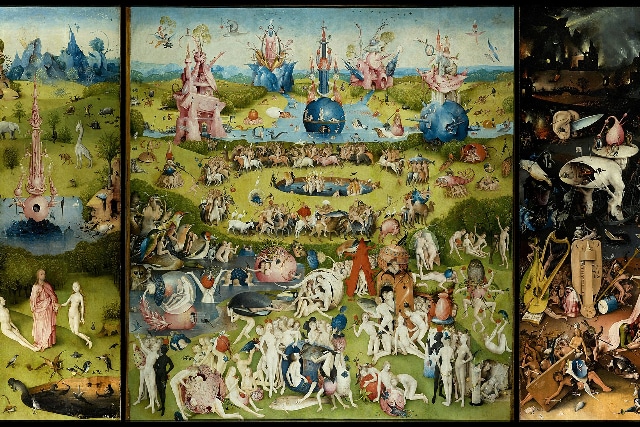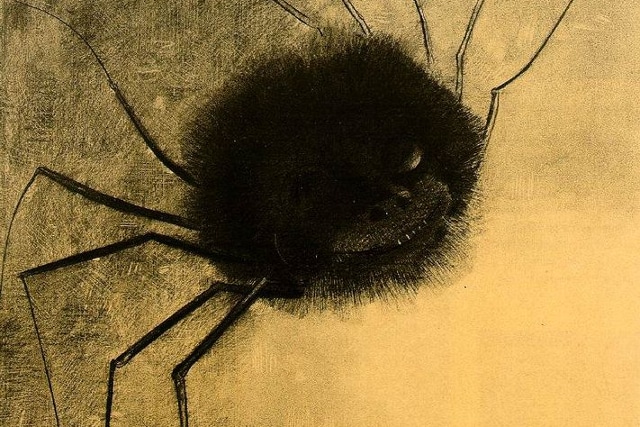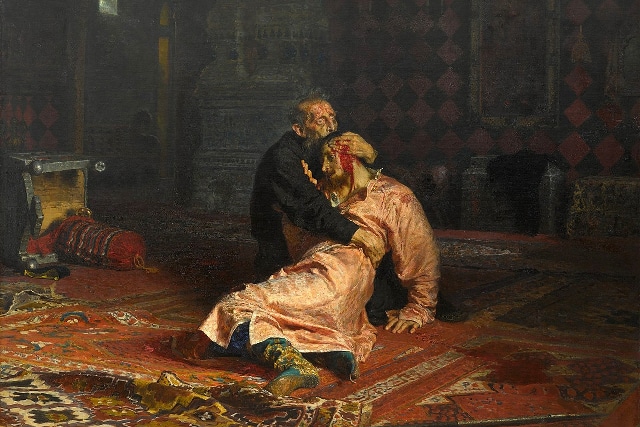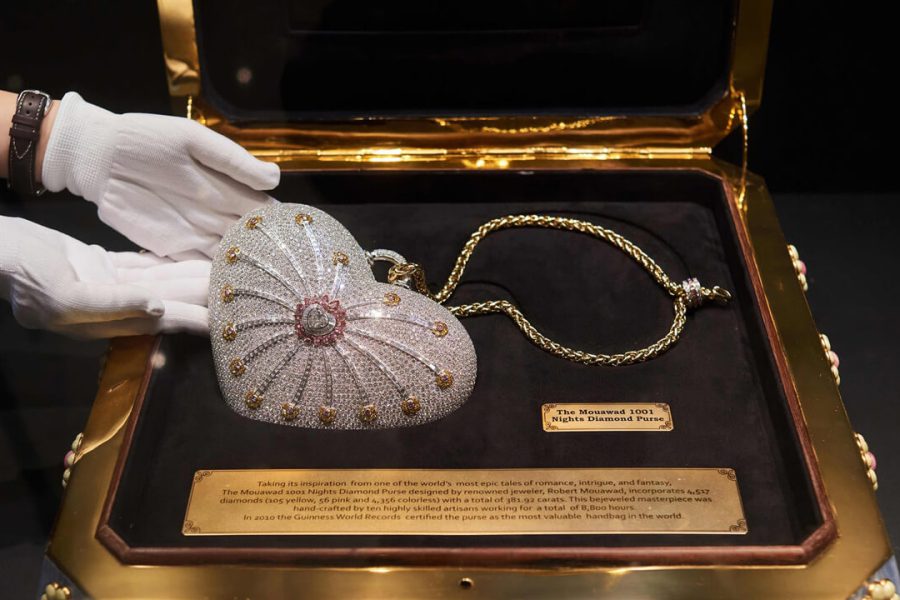Modern artists love to shock. But that's not particularly new. While it's easy to imagine that older art was limited by the (presumably) delicate sensibilities and puritanical morals of the time, many classic works are outshone by horror films. Here are ten of the most disturbing.
10. The Garden of Earthly Delights - Hieronymus Bosch, c. 1500-1505

The title of this triptych refers to the second panel: "a false paradise given over to the sin of lust." The panel on the right depicts the true earthly Paradise, the Garden of Eden, and the panel on the left depicts Hell.
Naturally, it’s the last one that’s most disturbing. Teeming with demons and tortured souls, it’s as shocking today as it was in 1505. Being Bosch, there’s a lot to take in: souls swallowed whole by a bird-headed demon and thrown down the drain; a pig in a monk’s veil; people submerged in freezing water; people forced to eat toads; and so on. Then there’s the man whose butt is decorated with sheet music (you can read about this piece listen here ).
Bosch was not only an artist, but also a craftsman . On the side panels with loops, a transparent monochrome ball is visible: Earth on the third day of Creation .
9. Smiling Spider - Odilon Redon, 1887

As a child, Odilon Redon was a "sad and weak child" who always "looked for shadows." It's a calling that has never left him. When asked what he loves to draw most, he simply replied, "My monsters."
Drawing on his interests in natural history, psychiatry and microscopy, his charcoal and lithographic creatures were, to say the least, nightmarish. Collectively, they are known as his noirs or "black things." Besides the smiling spider (and his crying analogue ), these include: a horned skeleton; a cactus man; a hairy cyclops; an egghead in an egg cup; and an unfortunate swamp flower.
Although they are fantastically varied, most of them have one thing in common: their human faces or features, even if it is only one eye. This is characteristic of the Symbolist movement. It represents the artist's desire to aspire to higher states and visions. And although his use of only black may seem contrary to this goal, Redon explained why he chose it : "Black must be respected, nothing prostitutes it. It does not please the eye or arouse sensuality. It is an agent of the mind much more than the most beautiful color on the palette or prism."
8. The Ghost of Kohada Koheiji - Katsushika Hokusai, c. 1831
You may know Hokusai from his famous "The Big Wave" . But he is also famous in Japan for his paintings yurei-zu with images of ghosts. Onri? - evil spirits popularized franchise "Ring" , were very common plots for this genre.
In this woodblock print, Hokusai depicts the ghost of a murdered man actor kabuki theatre Kohada Koheiji. Drowned wife and her lover in the swamp , Koheiji returned for revenge. Interestingly, the Edo period officials sought to censor this work not because she was scary, but because they thought the actors were immoral.
Genre yurei-dzu was not always disturbing; some works depicted benevolent spirits, such as ubume - dead mothers who miss their children. But they're all pretty creepy.
7. The Brutal Murders of Saisaburo Ohagi - Yoshitoshi Tsukioka, ca. 1867

Looks like yurei-zu , but are oriented towards the living, chimidoro-e ("bloody") and muzan-e ("cruel") engravings and paintings. « Last "great master" Woodblock prints Yoshitoshi Tsukioka was prolific in both of these genres. Tsukioka, based on performances kabuki And But , includes the following works : Naosuke Gombei ripping off his face; Shirai Gompachi cutting down his attacker with fire; Furuthei Hachirobei killing a woman in a cemetery; and Fukuoka Mitsugi with flying papers and a severed head.
The print shown here, Saisaburô Cruelly Murders Ohagi, is typical of the violent and gory genres. Taken from plays kabuki , Based on the novel, it shows the spurned Saisaburō hacking at his lover with a samurai sword. With Ohagi tied up and suspended, all power lies with the killer.
6. "Severed Heads" - Theodore Gericault, 1818
Gericault was fascinated by death and autopsy So much so that during surgery for a spinal tumor, he refused anesthesia in order to observe behind the operation in the mirror He died some time later.
"Severed Heads" is a macabre still life of body parts that he kept in his studio. He also kept corpses, which he set up as mannequins to study the dead. All this was preparation for his grand masterpiece. "The Raft of the Medusa" (1818–19), another disturbing work – at least politically. It depicts the scandalous aftermath of a recent shipwreck, in which senior officers leave lower-ranking officers to die before cannibalizing each other to survive. Géricault was so determined to finish this critique of the establishment that he shaved off his curly hair to ensure that he stayed inside out of vanity.
5. Dog – Francisco Goya, 1819–1823

Between 1819 and 1823, the aging and withdrawn court painter Francisco Goya locked himself in a farmhouse. He spent the next few years deaf and alone, painting in desperation on the walls. The images were not meant to be seen. But half a century later, the building's new owner moved the frescoes on canvas . Collectively, they are known as the Black Paintings, not so much for their dark palette but for their harrowing subjects and themes. According to a guide at the Prado Museum, "Some people can't even look at them."
The series includes coven , on which Satan is present; a decaying old corpse, soup eater ; And fight to the death with batons.
But it is Dog that most disturbs many. It is also the simplest. There are no ghouls, no creepy grins, no decaying diners; there is little at all. All we see is a vague swell in the foreground (either a hill or a wave), a heavy sky in the background, and between them a lonely dog's head. Whatever you make of the image, its bleakness cannot help but disturb - as if a glimpse of Goya's despair .
Interestingly, of the 15 paintings found, only 14 are fully accounted for The fifteenth was stolen by the Marquis of Salamanca, and we still don’t know exactly what was in it.
4. "The Nightmare" - Henry Fuseli, 1781

Nightmare has always been popular. From its first exhibition at the Royal Academy in London, it “excited… extraordinary interest.” Everyone wanted a copy. Art snobs even looked down on Fuseli for allowing so many engravings ; Sigmund Freud and Mary Shelley There were drawings on the walls.
However, not everyone liked the work. Some felt that it lacked moral lessons: where was God in this room chair ? For the artist it didn't matter. Fuseli was looking for what the romantics called "the sublime," that is, the strongest emotion we have In this case, when our gaze meets the gaze of the demon, it is an attraction of fear and desire.
There's a pretty dark backstory there, too. While writing Nightmare, Fuseli was in love with someone else's fiancée. In fact, Her portrait can be found on the back of the canvas . In a letter to a friend, he recounted a vivid dream he had of making love to a woman, concluding that "anyone who touches her now commits adultery and incest! She is mine, and I am hers. And I will have her. That certainly adds something to the work. But was he the imp-like incubus, or the angry horse in the corner?
3. Ivan the Terrible and his son Ivan – Ilya Repin, ca. 1883-1885.

It is believed that in 1581 Ivan the Terrible (the first Tsar of Russia) killed his own son. It is not clear how or why. Some say it was a reaction to the fact that he saw his son's pregnant wife in her underwear (a moral insult to the Tsar). Others think it followed a more political dispute. Perhaps it was accidental, perhaps it was deliberate, but the remorse here is desperately evident. This son was Ivan's only heir; the other was mentally ill.
Even the artist was moved by the work, “seized with fear” as he painted. Ilya Repin recalled working obsessively “in a rush” and hiding the work in between. Once completed, it was banned by Alexander III and also hidden from public view (the first such ban in Russian history). Although it was not censored three months later, it has been controversial ever since. Haunted, one might even say.
In 1913, an icon painter took a knife to the canvas, slashing faces while shouting, “Enough death, enough bloodshed!” And when the gallery curator heard the news, he threw himself under a train. Repin later restored the old painting, but the work was never reliable. Another man attacked the painting in 2018, smashing the body of young Ivan with a pole from the gallery’s rope fence. Like many Russians, The vandal considered Ivan a saint , and the painting is blasphemous.
2. The Temptation of Saint Anthony – Salvator Rosa, 1645
Salvator Rosa was fascinated by demons, witches, black masses, and so on. Here he imagines St. Anthony meeting demons from Hell in the desert. While this is not the most famous depiction of the tale (it is rarely even mentioned), it is certainly the most disturbing. Even Bosch And Dali could not fully live up to this vision.
He got his ideas for the creature from medieval bestiaries and Bosch's paintings. However, it wouldn't look out of place in a horror film. How one art blogger noticed , in this there is something from xenomorph . Even today, 400 years later, we are still haunted by this demon.
The scariest part, however, has to be the belly button, as it tells us that this thing has a mother.
1. "Saturn Devouring His Son" - Peter Paul Rubens, 1636
Saturn is the Roman name for Cronus, a Titan in Greek mythology who personified aging and time. According to ancient myth, he usurped his father Uranus' throne as ruler of the universe. He then became afraid that one of his own sons would do the same, so he devoured them all at the moment of their birth (except Zeus, who ran away ).
Rubens' famous painting is not the only depiction of the myth; Goya also made one of his “Black Paintings.” But this is one of the most disturbing – not least because it makes us feel so helpless. We can do nothing but watch the child die. It’s an all-too-common feeling these days, as the media covers international conflicts, most of which also involve self-serving old men sacrificing the young to maintain their ill-gotten power. Fittingly, this painting was commissioned by Philip IV of Spain for one of his hunting lodges .
In case you're wondering, the three lights at the top are a picture planets saturn Before the invention of telescopes, astronomers viewed rings as peripheral stars or moons.













Оставить Комментарий